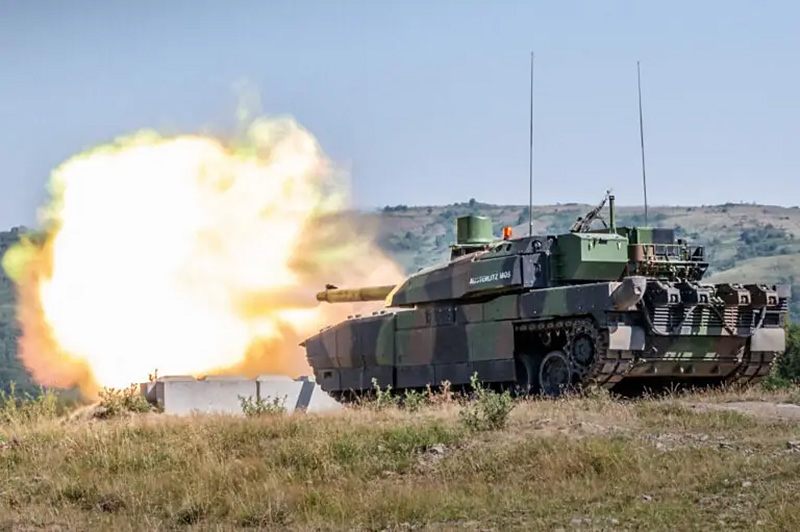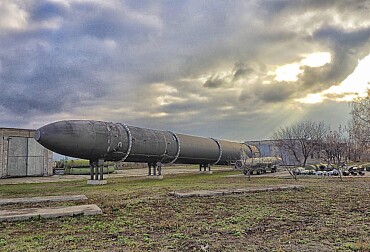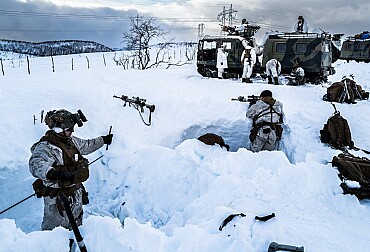Deterrence instead of stabilisation missions: Newly built French mechanised units will support NATO's eastern flank
France must reorganise its ground forces in view of the dynamic security situation in Central Eastern Europe. No other army in continental Europe has been so consistently optimised for intervention operations with units armed only with light equipment. Not surprisingly, Paris has so far been primarily responsible for security threats on the southern flank of the North Atlantic Alliance. It did not need mechanized forces for stabilization missions in Africa. French military strategists now see the Armée de Terre in a similar situation to that on the eve of the lost war against Prussia in 1870-1871.
"In the context of today's rapid strategic developments, the French armed forces are going through a similar phase to that of the late 19th century," said Colonel Frédéric Jordan of the École de guerre, a military school in Paris, during the parliamentary hearing. "At that time, the army was involved in several expeditionary missions, for example in Mexico and Italy, without our country being aware of the growing military threats in its vicinity. These eventually led to the war of 1870 and the First World War." As for the modern use of machine guns, artillery and trench warfare, the military command in Paris failed to learn the lessons of the Russo-Japanese War of 1904-1905 and "fell behind the times" before 1914, according to the German magazine Loyal.
Today, the French do not want to repeat the same mistake and their armed forces are preparing to adapt to the new situation. However, it remains important for Paris to be able to secure its overseas territories and protect its areas of interest. In addition to the former African colonies, the French islands in the Indian (Mayotte and Réunion) and Pacific (French Polynesia, New Caledonia, Wallis and Futuna) oceans are of particular importance. France will therefore not abandon the concept of a rapid reaction expeditionary army and will also retain its nuclear weapons, which it sees as a multiplier of conventional forces. There are no plans to expand the number of men, the ground forces are to remain at 77 000 soldiers (in contrast, the Czech Army and the Bundeswehr are counting on increasing their numbers).

Geographically, Berlin and Paris seem to have divided Central Eastern Europe into a north-eastern and a south-eastern sector. The small Baltic states have been given to Germany, which is setting up a NATO forward defence in the form of a permanent military base in Lithuania. France, on the other hand, provides a battle group in Romania (Mission Aigle) and contributes 1,000 armed forces personnel. The French are also participating in the LYNX mission in Estonia (about 350 troops) under British command. Thomas Gassilloud, former chairman of the defence committee, described the logic for the deployment of French troops on NATO's eastern flank as follows: "It is better to have 1,000 [French] troops in Romania with a nuclear deterrent than 5,000 [German] troops without a deterrent."
The French army wants to create a combat-capable division for the South-Eastern wing of the North Atlantic Treaty Organization (NATO) under the New Force Model. In three years' time, the "Division 2027" is to be available with 19,000 troops and can be deployed in Romania, for example, within 30 days. It is expected to be fully operational by 2030. The number of soldiers in reserve for the ground forces will double from 24,000 to 48,000 individuals because of this change.
The Armée de Terre will continue to be two divisions in size. "In the future, the divisions will be regionalised. The aim is to focus one division on our missions in Europe and the Middle East. The other division will take over Africa and the Indo-Pacific," said a French defence ministry spokesman. The "European division" will focus on deterring Russia. The "World Division" will form a reserve and provide forces to protect overseas territories. It will also be responsible for "preventive and influence" operations, which includes participating in military exercises or training partner countries' troops.
Prevention and influence operations will become a new concept for Africa. The intervention-based approach is too costly and therefore unsustainable for Paris and has completely collapsed in recent years. Many traditional security partnerships have come to an end; France has been pushed out of Mali and Niger by Russia, for example. In recent years, Moscow has become increasingly willing to engage as a military partner on the side of African authoritarian governments it seeks to enlist as allies against the West.
France now seeks to consolidate its eroded position in Africa. The 1,500-strong contingent in strategically located Djibouti in the Horn of Africa remains in place. In West Africa, however, the presence in Gabon, Ivory Coast and Senegal is being massively reduced from 2,300 to 600 troops. Paris is attempting to slowly rebuild its influence through small contingents as an education and training partner. So far, according to Loyal magazine, this approach does not seem to be working. Chad, another African country, recently ended security cooperation with France.
Now back to Europe. To make the "European Division" deployable and combat capable on NATO's eastern flank, brigades and regiments will be assigned to one of four commands called "Alpha": 1) reconnaissance, 2) long-range fires, 3) logistics, or 4) special forces and cyber. In addition, the CAPR (Commandement des actions dans la profondeur et du renseignement), a deep strike and reconnaissance command, will be a new addition to the French army, bringing together a brigade each of reconnaissance, artillery and combat helicopters. These units are to be used for rapid reconnaissance of the attacker's centres of decision-making to a depth of several hundred kilometres and to destroy command posts or logistics hubs in order to break the attacker's momentum early in the conflict.
Now back to Europe. To make the "European Division" deployable and combat capable on NATO's eastern flank, brigades and regiments will be assigned to one of four commands called "Alpha": 1) reconnaissance, 2) long-range fires, 3) logistics, or 4) special forces and cyber. In addition, the CAPR (Commandement des actions dans la profondeur et du renseignement), a deep strike and reconnaissance command, will be a new addition to the French army, bringing together a brigade each of reconnaissance, artillery and combat helicopters. These units are to be used for rapid reconnaissance of the attacker's centres of decision-making to a depth of several hundred kilometres and to destroy command posts or logistics hubs in order to break the attacker's momentum early in the conflict.
To deploy the "European Division" on the continent, the French established a new operational command in October 2024 - Commandement Terre Europe, based in Lille. Its dress rehearsal, especially logistical, will be the "Dacian Spring 25" military exercise this spring. Although the EU and NATO have so far failed to establish standardised and practical rules for the logistics of their deployments, a PESCO (Permanent Structured Cooperation) project led by the Netherlands should deliver a solution in 2026. Early last year, the Netherlands, Germany and Poland expressed their intention to propose a "model corridor" for the deployment of Western European troops on NATO's eastern flank. However, no results have been achieved so far.
The French army has to transfer its forces from Western Europe to Romania, 2000 km away, where an alliance logistics base is being established. Paris is now entitled to use the Brasov airport in the Carpathian Mountains for its military airlift fleet. Agreements have been concluded with Greece for the use of port facilities for sea transport. Material arriving there by ship will be transported by rail via Bulgaria to Cincu in Romania, the main base of the French-led NATO battle group.
Movements of Allied troops and military material do not avoid the Czech territory. Although the Czechs are not directly participating in this year's alliance exercise "Steadfast Dart 2025" in Romania, British troops (104 Theatre Sustainment Brigade) will pass through the Czech Republic on 15-26 January. About 300 soldiers and a hundred vehicles heading from Germany to Romanian territory will be divided into several convoys. The smooth running of the logistics operation (Host Nation Support) is being handled by the Logistics Agency from the operations centre in Stará Boleslav. The return of the British troops will take place along the same route in mid-March. Similar military transfers may take place in the future and it will be useful for Prague to follow the Dutch project for military logistics rules within the EU and NATO.
Geopolitical changes in Europe are forcing France to deal more intensively with the threat coming from the east, not just the southern migratory threat and the Mediterranean. The French are building their main base in NATO's eastern flank in Romania, where they currently have about 1,000 troops. In addition to the land route, Paris uses shipping, Greek ports and a railway running through Bulgarian territory to supply Romanian troops. The Netherlands is currently working on rules for the transport of military equipment and troops within the EU and NATO, and the results of its work are expected in 2026.









